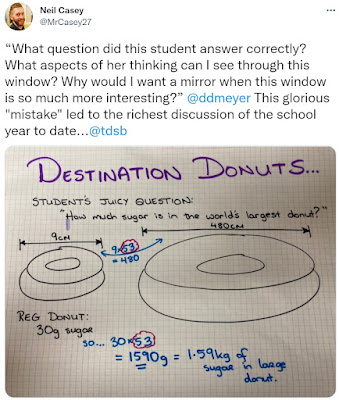I broke math
A few months ago, a student ran into class early one morning
with an excited look on her face. “I broke math!” she exclaimed.
[The day before, we had just learned about imaginary numbers
and explored a dimension where square roots of negative numbers were possible. What an unjust name for that number set – they deserve to be acknowledged as
real! see more here]
I asked her to explain how she had broken math; she
grabbed a space on the whiteboard and started to show what she thought was a
loophole in the reasoning we had explored the day prior. Alas, mathematicians
had already accounted for that loophole and she did not break math that day,
but what a powerful moment for her.
In other subjects and classes, students sometimes (hopefully
often) get to create. Quite often, these creations take shape explicitly in the
products of their thinking – paintings in art class, poetry and essays in
language arts, lab results in science, and so on.
How do we help kids see math? Do they see it as a construct
that was created by other people and only to be received? Or do we help them
see it as ideas that they can create themselves, bend, and even break? I was
excited by the fact that this student had viewed mathematics as a subject that
she had a role in forming; to even think that she could play with it in order
to find a loophole is incredibly empowering.
It made me reflect on how I can help more kids approach
mathematics with this mindset. I thought
of an idea that had been in the back of my mind for a long time: teaching
mathematics concepts by exploring what they are not.
I learned early in my career that one of the worst ways to
introduce a new term was to provide the definition. For example, the definition
of a polynomial is “an expression of
more than two algebraic terms; the sum of several terms that contain different
powers of the same variables”.
This does not help someone who is learning this term for the
first time make any sense of what it means. I always wondered what would happen
if instead, we talked about what a polynomial is not. We would still draw pictures, talk about examples, but what if we also
spend just as much time exploring visual models and expressions that are not polynomials.
A foundational math concept that I can see this working
well would be when students first learn about place value. We spend a lot of
time talking about what each place means and represents, but don’t really
explore different number systems. To
get to the core idea of how our base-10 number system works, it would be
helpful to explore systems that are not base-10.
James Tanton from G’Day math has developed a construct called exploding dots that does an amazing job laying the foundation for this exploration. I encourage you to watch it regardless of what level of math you teach. Here, students get to truly see what happens when we run out
of digits to express values in different places. It’s intuitive, based on an intriguing
story, and engaging to play with – it invites learners to bend the rules.
When I ask teachers why they don’t let kids explore the
negative space around a new concept more often, I always hear that “the kids
aren’t ready” or that “it will confuse them”. I encourage teachers to give it a
try; consider that new concepts are new to kids anyway, providing a clear cut
definition doesn’t paint the whole picture. Building experiences that let them
see both what something is and isn’t will help them construct a deeper
understanding. It will hopefully show them that they have a role in creating
new ideas in mathematics.




Comments
Post a Comment